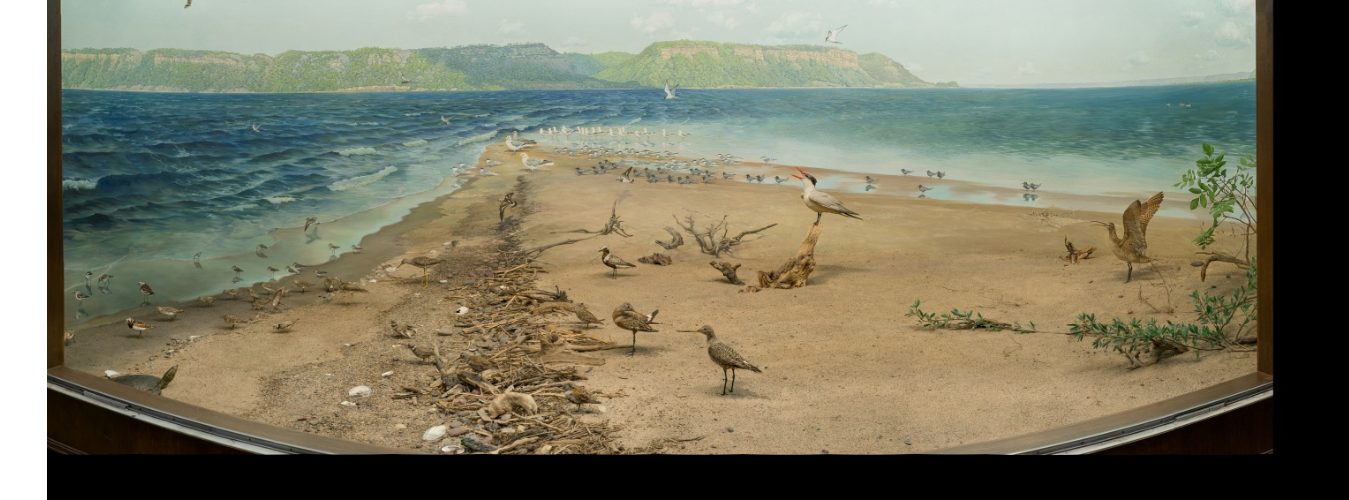by Louise Segreto, Chapter Historian
Recently, I visited the new Bell Museum at the University of Minnesota’s St. Paul Campus in Falcon Heights. The Museum has reinvented itself from its cramped, dark and poorly accessible former home at the University’s main campus. With a construction and relocation budget of almost $80 million plus lots of creative thought, the Bell Museum has been transformed into a world class natural history museum of which Minnesotans can be proud. There is so much to learn and explore at the Bell for all ages, but it’s the Museum’s amazing wildlife dioramas that will transport you to another place!
The Museum was originally created by the Minnesota legislature in 1872 to preserve a record of our State’s birds, wildlife, plant life and geology. It was named after James Ford Bell, the founder of General Mills and an early conservationist. The late 1800s were a time of ecological exploitation and rampant disregard for protecting the environment. Our buffalo herds (originally 25-30 million) across the Great Plains were slaughtered almost to extinction by the late 1800s. And, our skies were no longer blackened by passenger pigeons flying overhead. The women’s millinery (hat) trade alone wiped out millions of birds during this dark period. Even back then, people were becoming alarmed about the loss of habitat and polluted waters.
Early naturalists like Minnesota’s famed birder, T.S. Roberts, and several young colleagues formed an informal group called “The Youth Naturalist Society” who collected nests, eggs and birds for the Museum’s first collections. They hunted and killed birds and wildlife. During these years, “shotgun ornithology” was the accepted collection practice for the Museum since there was an absence of legislation protecting birds and wildlife.
Before dioramas, early natural history museums were uninspiring “dead zoos” of stuffed animal skins and dusty cabinets full of curious natural history collections. For those that are not familiar with dioramas, they are three-dimensional realistic life size views of nature enclosed by glass with naturalistically painted foregrounds and backgrounds that were very popular in the 1890s. Backgrounds painted on a slightly curved surface provide a perspective that allow viewers a sense of immersion in the scene depicted. Taxidermied animals posed in groups exhibiting natural behaviors make the scene come to life. The Bell Museum’s Dioramas are world class amazing works of both art and cultural history. The fine attention to detail in the Bell Dioramas is amazing having been painted and prepared by famous naturalists/artists of the times: Walter Breckenridge (an Izaak Walton League Member with a Izaak Walton Chapter named after him) and Francis Lee Jaques (illustrator of many of Sigurd Olson’s books, also the namesake of a Chapter). Originally, the purpose of natural history dioramas was to educate the public about the growing need for habitat conservation in a museum setting. Over 100 years later, the Bell Museum is still continuing that mission. The Bell’s Dioramas have been refreshed and audio sound tracks and other interactivity have been added to further enhance the experience.
The story of the Bell Museum’s Dioramas, how they were made and how they were painstakingly moved from the old building to the new Bell is fascinating and is the subject of the co-production Twin Cities PBS-TPT/Bell Museum’s film: “Windows to Nature” (26 min). View it on-line free by clicking here.
Over 45 years ago, my mother took me to see the magnificent Akeley Hall of African Mammals at the Museum of Natural History in New York City. The experience profoundly changed my thinking about the world. The Akeley Hall Dioramas taught me that the world was a phenomenally beautiful and diverse place. My curiosity was kindled about far-away places that I could then only dream about. As I recently walked through the Bell Museum, I stopped and observed some young girls standing quietly in front of a large diorama of the shore of Lake Pepin (Sand Point at Frontenac State Park) showcasing a large assortment of birds calling to one another with the stunning beauty of the surrounding bluff lands across the expanse of the Mississippi River in the background. I recognized the same look of awe and wonder in their eyes! For children and nature lovers of all ages, we highly recommend a visit to the new Bell Museum!
Lake Pepin- Background by Frances Lee Jaques, Foreground by Walter Breckenridge, Photo by Tom Nelson, University of Minnesota
